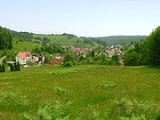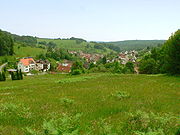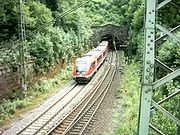
Heigenbrücken
Encyclopedia
Heigenbrücken is a municipality
in the Aschaffenburg district
in the Regierungsbezirk
of Lower Franconia
(Unterfranken) in Bavaria
, Germany
and seat of the Verwaltungsgemeinschaft (Administrative Community) of Heigenbrücken.
(range).
 Heigenbrücken’s one outlying Ortsteil is Jakobsthal, lying about 5 km away from the main centre.
Heigenbrücken’s one outlying Ortsteil is Jakobsthal, lying about 5 km away from the main centre.
, Heigenbrücken passed at Secularization
to the newly formed Principality of Aschaffenburg
, with which it passed in 1814 (by this time it had become a department of the Grand Duchy of Frankfurt) to Bavaria. In the course of administrative reform in Bavaria, the current community came into being with the Gemeindeedikt (“Municipal Edict”) of 1818.
Heigenbrücken lies on an old road leading through the Spessart between Würzburg and Aschaffenburg. The placename ending —brücken (“bridges”) likely refers to that.
(as at 1 January 2005)
(as at municipal election held on 2 March 2008)
). In 2002 he succeeded Hans Wüst (SPD).
The community’s arms
might be described thus: Argent a gurgle glass gules palewise between two oak leaves vert palewise, in base a mound of the third surmounted by a tunnel portal masoned of the first with a tunnel sable.
The Schwarzkopftunnel, which at the building of the Ludwig-Westbahn (railway) was said to be a special technical achievement, and which is the community’s landmark, was included as a charge
in the arms. The two oak leaves refer to the community’s geographical location in the Spessart, which has a wealth of oak trees. The “gurgle glass” (for want of a better translation – the German blazon calls for a Kutterolf, also known in German
as an Angster or a Gluckerflasche) is a bottle or drinking vessel of a kind known since 3rd-century Cologne, and which was in use up until the 19th century; the charge stands for the once important glass industry in the community. Referring to the community’s former allegiance to Electoral Mainz
are the tincture
s argent and gules (silver and red).
and forestry
in 1998. In producing businesses this was 59, and in trade and transport
11. In other areas, 97 workers on the social welfare contribution rolls are employed, and 782 such workers work from home. There is one processing business. Three businesses are in construction, and furthermore, in 1999, there were no agricultural operations.
The firm Wenzel Präzision runs a hotel with a gourmet restaurant, the “Villa Marburg” at the intersection of the streets Lindenallee and Werner-Wenzel-Straße.
 Heigenbrücken lies on the Aschaffenburg
Heigenbrücken lies on the Aschaffenburg
-Würzburg
long-distance railway line of the Main-Spessart-Bahn. Heigenbrücken railway station lies just east of the peak tunnel on this line, the Schwarzkopftunnel, which also appears in the community’s arms.
From a railway signalling point of view, the 925 m-long Schwarzkopftunnel lies within Heigenbrücken railway station. This peculiarity stems from a pushing operation
, still undertaken today, between Laufach and Heigenbrücken. Heavy goods trains come to a stop at Laufach station, where a helper locomotive joins the train’s tail end to help the train’s main locomotive get the train up the Spessart Ramp, which reaches a steepness of 1:47 (some 21‰). The tunnel itself is built with no gradients to speak of. Just before the tunnel portal, the helper locomotive leaves the goods train, which has now covered the steepest gradient and continues on its way southeastwards. So that the helper locomotive does not need to go through the tunnel and into the passenger transport complex (which would lead to disruption of normal operations), the tracks at the Aschaffenburg (that is to say, far) end of the tunnel are so arranged as to allow it to cross over to the other track and travel back to Laufach. The points
needed for this also belong to the Heigenbrücken signal box
, meaning that Heigenbrücken station stretches right through the tunnel.
Currently (as of 2009) being planned is a replacement of this tunnel by a new arrangement owing to its great age. Also in the works is a plan to realign the line from Laufach to Heigenbrücken somewhat so that the slope can be reduced. An end to the pushing operation is therefore to be foreseen sometime in the next few years. Four new tunnels would replace the Schwarzkopftunnel. The names for these new tunnels are Falkenbergtunnel (approximately 2600 m, making it the longest tunnel in the group), Hirschbergtunnel, Metzbergtunnel and Haintunnel. Trains would be allowed to double their speed through the new tunnels from the current 70 km/h (43 MPH) to 140 km/h (87 MPH). Construction is planned to begin in 2011 and should be completed by 2017 at a cost of approximately 321 million Euros.
There is also limited bus service to neighboring communities, connecting those communities to the Heigenbrücken bahnhof (railway station).
Municipalities of Germany
Municipalities are the lowest level of territorial division in Germany. This may be the fourth level of territorial division in Germany, apart from those states which include Regierungsbezirke , where municipalities then become the fifth level.-Overview:With more than 3,400,000 inhabitants, the...
in the Aschaffenburg district
Aschaffenburg (district)
Aschaffenburg is a district in Bavaria, Germany. It is bounded by the districts of Darmstadt-Dieburg, Offenbach, Main-Kinzig , the districts Main-Spessart and Miltenberg, and the town of Aschaffenburg....
in the Regierungsbezirk
Regierungsbezirk
In Germany, a Government District, in German: Regierungsbezirk – is a subdivision of certain federal states .They are above the Kreise, Landkreise, and kreisfreie Städte...
of Lower Franconia
Lower Franconia
Lower Franconia is one of the three administrative regions of Franconia in Bavaria , Germany ....
(Unterfranken) in Bavaria
Bavaria
Bavaria, formally the Free State of Bavaria is a state of Germany, located in the southeast of Germany. With an area of , it is the largest state by area, forming almost 20% of the total land area of Germany...
, Germany
Germany
Germany , officially the Federal Republic of Germany , is a federal parliamentary republic in Europe. The country consists of 16 states while the capital and largest city is Berlin. Germany covers an area of 357,021 km2 and has a largely temperate seasonal climate...
and seat of the Verwaltungsgemeinschaft (Administrative Community) of Heigenbrücken.
Location
Heigenbrücken lies in the Bavarian Lower Main (Bayerischer Untermain) in the middle of the SpessartSpessart
The Spessart is a low mountain range in northwestern Bavaria and southern Hesse, Germany. It is bordered on three sides by the Main River. The two most important towns located at the foot of the Spessart are Aschaffenburg and Würzburg....
(range).
Constituent communities

History
In 1477, Heigenbrücken had its first documentary mention as Heygerbruch. Along with the Archbishopric of MainzArchbishopric of Mainz
The Archbishopric of Mainz or Electorate of Mainz was an influential ecclesiastic and secular prince-bishopric in the Holy Roman Empire between 780–82 and 1802. In the Roman Catholic Church hierarchy, the Archbishop of Mainz was the primas Germaniae, the substitute of the Pope north of the Alps...
, Heigenbrücken passed at Secularization
Secularization
Secularization is the transformation of a society from close identification with religious values and institutions toward non-religious values and secular institutions...
to the newly formed Principality of Aschaffenburg
Principality of Aschaffenburg
The Principality of Aschaffenburg was a principality of the Holy Roman Empire and the Confederation of the Rhine from 1803–10. Its capital was Aschaffenburg....
, with which it passed in 1814 (by this time it had become a department of the Grand Duchy of Frankfurt) to Bavaria. In the course of administrative reform in Bavaria, the current community came into being with the Gemeindeedikt (“Municipal Edict”) of 1818.
Heigenbrücken lies on an old road leading through the Spessart between Würzburg and Aschaffenburg. The placename ending —brücken (“bridges”) likely refers to that.
Religion
- Catholic: 1,961
- EvangelicalEvangelical Church in GermanyThe Evangelical Church in Germany is a federation of 22 Lutheran, Unified and Reformed Protestant regional church bodies in Germany. The EKD is not a church in a theological understanding because of the denominational differences. However, the member churches share full pulpit and altar...
: 255 - other: 376
(as at 1 January 2005)
Population development
Within the municipal area lived 2,330 inhabitants in 1970, 2,332 in 1987 and 2,499 in 2000.Community council
The council is made up of 15 council members, counting the mayor.| CSU Christian Social Union of Bavaria The Christian Social Union in Bavaria is a Christian democratic and conservative political party in Germany. It operates only in the state of Bavaria, while its sister party, the Christian Democratic Union , operates in the other 15 states of Germany... |
SPD Social Democratic Party of Germany The Social Democratic Party of Germany is a social-democratic political party in Germany... |
Freie Wähler Heigenbrücken-Jakobsthal | Total | |
| 2008 | 6 | 6 | 3 | 15 seats |
(as at municipal election held on 2 March 2008)
Mayors
The mayor is Werner Englert (SPDSocial Democratic Party of Germany
The Social Democratic Party of Germany is a social-democratic political party in Germany...
). In 2002 he succeeded Hans Wüst (SPD).
Coat of arms
The community has borne arms since June 1977.The community’s arms
Coat of arms
A coat of arms is a unique heraldic design on a shield or escutcheon or on a surcoat or tabard used to cover and protect armour and to identify the wearer. Thus the term is often stated as "coat-armour", because it was anciently displayed on the front of a coat of cloth...
might be described thus: Argent a gurgle glass gules palewise between two oak leaves vert palewise, in base a mound of the third surmounted by a tunnel portal masoned of the first with a tunnel sable.
The Schwarzkopftunnel, which at the building of the Ludwig-Westbahn (railway) was said to be a special technical achievement, and which is the community’s landmark, was included as a charge
Charge (heraldry)
In heraldry, a charge is any emblem or device occupying the field of an escutcheon . This may be a geometric design or a symbolic representation of a person, animal, plant, object or other device...
in the arms. The two oak leaves refer to the community’s geographical location in the Spessart, which has a wealth of oak trees. The “gurgle glass” (for want of a better translation – the German blazon calls for a Kutterolf, also known in German
German language
German is a West Germanic language, related to and classified alongside English and Dutch. With an estimated 90 – 98 million native speakers, German is one of the world's major languages and is the most widely-spoken first language in the European Union....
as an Angster or a Gluckerflasche) is a bottle or drinking vessel of a kind known since 3rd-century Cologne, and which was in use up until the 19th century; the charge stands for the once important glass industry in the community. Referring to the community’s former allegiance to Electoral Mainz
Archbishopric of Mainz
The Archbishopric of Mainz or Electorate of Mainz was an influential ecclesiastic and secular prince-bishopric in the Holy Roman Empire between 780–82 and 1802. In the Roman Catholic Church hierarchy, the Archbishop of Mainz was the primas Germaniae, the substitute of the Pope north of the Alps...
are the tincture
Tincture (heraldry)
In heraldry, tinctures are the colours used to emblazon a coat of arms. These can be divided into several categories including light tinctures called metals, dark tinctures called colours, nonstandard colours called stains, furs, and "proper". A charge tinctured proper is coloured as it would be...
s argent and gules (silver and red).
Agriculture and forestry
According to official statistics, there were 20 workers on the social welfare contribution rolls working in agricultureAgriculture
Agriculture is the cultivation of animals, plants, fungi and other life forms for food, fiber, and other products used to sustain life. Agriculture was the key implement in the rise of sedentary human civilization, whereby farming of domesticated species created food surpluses that nurtured the...
and forestry
Forestry
Forestry is the interdisciplinary profession embracing the science, art, and craft of creating, managing, using, and conserving forests and associated resources in a sustainable manner to meet desired goals, needs, and values for human benefit. Forestry is practiced in plantations and natural stands...
in 1998. In producing businesses this was 59, and in trade and transport
Transport
Transport or transportation is the movement of people, cattle, animals and goods from one location to another. Modes of transport include air, rail, road, water, cable, pipeline, and space. The field can be divided into infrastructure, vehicles, and operations...
11. In other areas, 97 workers on the social welfare contribution rolls are employed, and 782 such workers work from home. There is one processing business. Three businesses are in construction, and furthermore, in 1999, there were no agricultural operations.
The firm Wenzel Präzision runs a hotel with a gourmet restaurant, the “Villa Marburg” at the intersection of the streets Lindenallee and Werner-Wenzel-Straße.
Transport

Aschaffenburg
Aschaffenburg is a city in northwest Bavaria, Germany. The town of Aschaffenburg is not considered part of the district of Aschaffenburg, but is the administrative seat.Aschaffenburg is known as the Tor zum Spessart or "gate to the Spessart"...
-Würzburg
Würzburg
Würzburg is a city in the region of Franconia which lies in the northern tip of Bavaria, Germany. Located at the Main River, it is the capital of the Regierungsbezirk Lower Franconia. The regional dialect is Franconian....
long-distance railway line of the Main-Spessart-Bahn. Heigenbrücken railway station lies just east of the peak tunnel on this line, the Schwarzkopftunnel, which also appears in the community’s arms.
From a railway signalling point of view, the 925 m-long Schwarzkopftunnel lies within Heigenbrücken railway station. This peculiarity stems from a pushing operation
Bank engine
A bank engine or helper engine or pusher engine is a railway locomotive that temporarily assists a train that requires additional power or traction to climb a grade...
, still undertaken today, between Laufach and Heigenbrücken. Heavy goods trains come to a stop at Laufach station, where a helper locomotive joins the train’s tail end to help the train’s main locomotive get the train up the Spessart Ramp, which reaches a steepness of 1:47 (some 21‰). The tunnel itself is built with no gradients to speak of. Just before the tunnel portal, the helper locomotive leaves the goods train, which has now covered the steepest gradient and continues on its way southeastwards. So that the helper locomotive does not need to go through the tunnel and into the passenger transport complex (which would lead to disruption of normal operations), the tracks at the Aschaffenburg (that is to say, far) end of the tunnel are so arranged as to allow it to cross over to the other track and travel back to Laufach. The points
Railroad switch
A railroad switch, turnout or [set of] points is a mechanical installation enabling railway trains to be guided from one track to another at a railway junction....
needed for this also belong to the Heigenbrücken signal box
Signal box
On a rail transport system, signalling control is the process by which control is exercised over train movements by way of railway signals and block systems to ensure that trains operate safely, over the correct route and to the proper timetable...
, meaning that Heigenbrücken station stretches right through the tunnel.
Currently (as of 2009) being planned is a replacement of this tunnel by a new arrangement owing to its great age. Also in the works is a plan to realign the line from Laufach to Heigenbrücken somewhat so that the slope can be reduced. An end to the pushing operation is therefore to be foreseen sometime in the next few years. Four new tunnels would replace the Schwarzkopftunnel. The names for these new tunnels are Falkenbergtunnel (approximately 2600 m, making it the longest tunnel in the group), Hirschbergtunnel, Metzbergtunnel and Haintunnel. Trains would be allowed to double their speed through the new tunnels from the current 70 km/h (43 MPH) to 140 km/h (87 MPH). Construction is planned to begin in 2011 and should be completed by 2017 at a cost of approximately 321 million Euros.
There is also limited bus service to neighboring communities, connecting those communities to the Heigenbrücken bahnhof (railway station).
Education
The following institutions are to be found in Heigenbrücken (as at 1999):- KindergartenKindergartenA kindergarten is a preschool educational institution for children. The term was created by Friedrich Fröbel for the play and activity institute that he created in 1837 in Bad Blankenburg as a social experience for children for their transition from home to school...
s: 100 kindergarten places with 79 children. - Elementary school: 1 with 17 teachers and 312 pupils.

